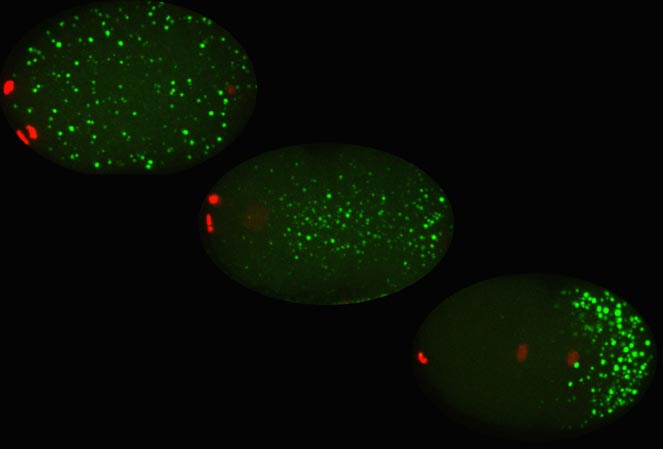New Trick Found for How Cells Stay Organized

Jenn Wang As time passes (left to right), RNA granules (green dots) segregate to the posterior of a newly fertilized C. elegans egg. Chromosomes are marked in red.
Fast Facts:
- RNA granules are tiny cellular compartments that are not bound by membranes like most other compartments.
- They were thought to not need a physical boundary, but they do.
- The boundary is a new type that resembles an irregularly shaped protein cage that revolves around the contents of the granule.
Organization is key to an efficient workplace, and cells are no exception to this rule. New evidence from Johns Hopkins researchers suggests that, in addition to membranes, cells have another way to keep their contents and activities separate: with ribbons of spinning proteins. A summary of their findings appears today in the journal eLife.
Each cell is a busy warehouse of activity. To keep things orderly, protein workers are “assigned” to specific areas of the cell where other workers are collaborating on the same project. Most of the project areas, or organelles, in the cell are cordoned off by flexible membranes that let things in and out on an as-needed basis, but some organelles, like RNA granules, do not seem to have clear boundaries.
RNA granules float throughout the watery space inside the cell and are responsible for transporting, storing and controlling RNA — DNA’s chemical cousin — which holds blueprints for proteins. Until now, researchers thought that the granules didn’t have concrete edges to separate them from the space outside.
“Before, the thinking was that RNA granules were like oil in water,” says Geraldine Seydoux, Ph.D., a Howard Hughes investigator and professor of molecular biology and genetics at the Johns Hopkins University School of Medicine. “Oil molecules create droplets because they are attracted to themselves, and so they are able to separate from surrounding water. Now we know that the separation of RNA granules from their watery surroundings is facilitated by a dynamic envelope that stabilizes them.”
Seydoux and her team worked with Eric Betzig, Ph.D., of Janelia Farm, who uses a state-of-the-art microscope that can detect rapidly moving particles. That microscope was key to detecting the irregularly shaped protein “cages” that surround the granules because they are constantly orbiting. When the researchers identified the proteins that create the cages, they were further surprised to find that the proteins are predicted not to interact with RNA and are rarely folded as most proteins are.
Seydoux says there are many questions left open about the nature of these protein cages and the RNA granules they surround, but “it is quite exciting to have discovered a new way that cells organize their contents.”
Other authors of the report include Jennifer Wang, Jarrett Smith, Helen Schmidt, Dominique Rasoloson, Alexandre Paix, Bramwell Lambrus and Deepika Calidas of the Johns Hopkins University School of Medicine, as well as Bi-Chang Chen of Janelia Farm.
This work was supported by the National Institute of Child Health and Human Development (R01HD37047) and the Howard Hughes Medical Institute.
Citations: eLife, Jan-2015; R01HD37047
Contact Information
Catherine Kolf
Senior Communications Specialist
ckolf@jhmi.edu
Phone: 443-287-2251
Mobile: 443-440-1929
Media Contact
All latest news from the category: Life Sciences and Chemistry
Articles and reports from the Life Sciences and chemistry area deal with applied and basic research into modern biology, chemistry and human medicine.
Valuable information can be found on a range of life sciences fields including bacteriology, biochemistry, bionics, bioinformatics, biophysics, biotechnology, genetics, geobotany, human biology, marine biology, microbiology, molecular biology, cellular biology, zoology, bioinorganic chemistry, microchemistry and environmental chemistry.
Newest articles

NASA: Mystery of life’s handedness deepens
The mystery of why life uses molecules with specific orientations has deepened with a NASA-funded discovery that RNA — a key molecule thought to have potentially held the instructions for…

What are the effects of historic lithium mining on water quality?
Study reveals low levels of common contaminants but high levels of other elements in waters associated with an abandoned lithium mine. Lithium ore and mining waste from a historic lithium…

Quantum-inspired design boosts efficiency of heat-to-electricity conversion
Rice engineers take unconventional route to improving thermophotovoltaic systems. Researchers at Rice University have found a new way to improve a key element of thermophotovoltaic (TPV) systems, which convert heat…



